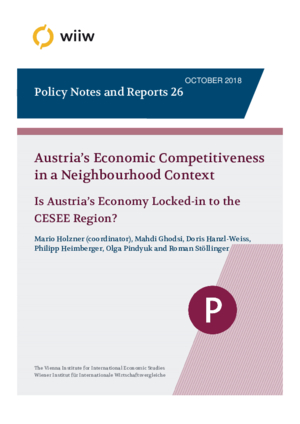Austria’s Economic Competitiveness in a Neighbourhood Context: Is Austria’s Economy Locked-in to the CESEE Region?
Mahdi Ghodsi, Doris Hanzl-Weiss, Philipp Heimberger, Mario Holzner, Olga Pindyuk and Roman Stöllinger
wiiw Policy Note/Policy Report No. 26, October 2018
21 pages including 11 Figures
Since the Eastern enlargement of the EU in 2004, Austria has lost global export market shares. At the same time exports to Central, East and Southeast Europe (CESEE) have gained a significant portion of Austria’s total exports. Moreover, in recent years Austrian GDP growth has slowed down and unemployment increased. In this context our main research question is whether the opening to the East has had a structural lock-in effect for Austria’s economy. In a novel approach on the territorial lock-in effect we apply a multi-perspective view from a microeconomic (firm-level), mesoeconomic (industry-level) and macroeconomic (country-level) perspective. The major finding is that by and large Austria is not subject to a lock-in effect into CESEE markets. On the contrary, the results suggest a growing internationalisation of the Austrian export structure. Nevertheless, policy recommendations that aim at further improving Austria’s competitiveness include a productivity‑oriented wage policy, an industrial policy that aims at technological upgrading, support for European policy measures that speed up income convergence across the continent as well as additional measures to internationalise Austrian businesses with a focus on the booming emerging markets in India and Africa.
Keywords: competitiveness, lock-in effect, total factor productivity, value added trade, real exchange rate, Eastern Europe, Austria
JEL classification: D24, F14, F41, E64
Countries covered: Austria, CESEE
Research Areas: International Trade, Competitiveness and FDI
